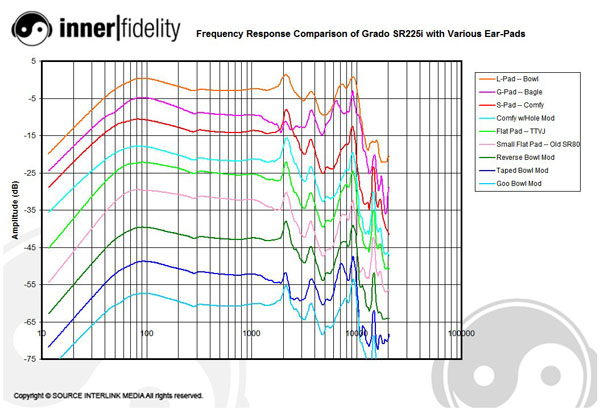| Columns Retired Columns & Blogs |
Evaluation of Grado Stock and Modified Ear-Pads Page 3
Evaluating the Modified Pads
Here's a repost of overall graph for this page.
Here's a repost of overall graph for this page.

The first modification for our viewing pleasure is the reverse bowls (forest green trace). You'll have to look carefully, but it does seem the bump at 2kHz is narrower, and the highs are slightly more rolled-off than the bowls. "Nicer mids; muffles highs slightly; slightly better bass slam," say my notes comparing the bowls reversed against the normal bowls. If you want to hear what flat pads sound like, flip your bowls around and it will give you the idea of what direction you'll go.
Now, the taped bowl mod, have a good hard look at the blue trace second from bottom. Again, an even narrower 2kHz blip; but more of the highs remain. Cool. How does it sound? "Much less barky; better impact; better controlled highs; still open and fast without tizz."
Holy Crapamoly, these sound pretty darn good!

Wow! Will you look at that: fast rise time on the leading edge with out the precipitous fall afterward, settling quickly into a nice flat top, while continuing to contain the high frequency info needed for detail. What did I think? "Much less barky; better impact; better controlled highs; still open and fast, but without as much tizz." Say! I must like these .. and I do.
Eeeeek! I like a pair of Grados!? Hmmm. Better listen some more ...

In the graph above, we can see that the taped pads (red) have about 5dB less energy than the stock bowls (blue) between 1.5kHz and 3kHz. This is exactly the region that troubles me. You'll also see a slight increase in bass response, and between the settling of the 2kHz stuff and the rise in bass you end up with a little less dished mid-range (though now tilted somewhat).
I'm gonna take a wild guess here and provide an hypothesis: When a transient is pumped into the chamber between the driver and ear, pressure radiates radially out towards the edge of the ear-pad. The boundary at the edge of the ear-pad provides the opportunity for an acoustic reflection, and therefor the opportunity for a resonant mode to develop. Because the pads are perfectly circular, the Q (quality of the resonator) could be high. The resonant mode is at 2130kHz; it's half wavelength (the first resonant mode) at my altitude and temperature is 3.086 inches. Guess what the pad diameter is? Yup, 3 inches.
More guessing: The Scotch tape is making the diameter of the edge of the foam pad stiff and supporting the foam inside. This improves the Q of the resonator by making its edge more reflective, which yields the narrowing of the spike at 2kHz. But with the tape's more rigid support, the foam might offer just a bit more resistance to the air passing, which lowers the level in the region surrounding 2kHz.
More guessing!? No way. Now it's your turn: buy some extra sets of bowl pads and mess around. I'm not sure what's going to work, but I do know that it will change things significantly. Post up your modifications in the comments below. Make sure you post pix, your listening impressions, and what makes you think your approach is a good idea. If I think it's a good idea too, I'd be happy to measure them for you and include the results here.
Hmmm.
One more thing ....
After spending three days listening to a bunch of Grado cans and modifying them, by the time I got to the end and was figuring out what the heck was going on, I sorta fell in love with the SR225i w/tape mod (the goo mod was still too bright with that added energy between 1.5kHz and 3kHz).
Yes. I will now recommend the SR225i w/tape mod ...
... and go eat a hat.
For more resources on Grado ear-pad mods read on.
- Log in or register to post comments




































